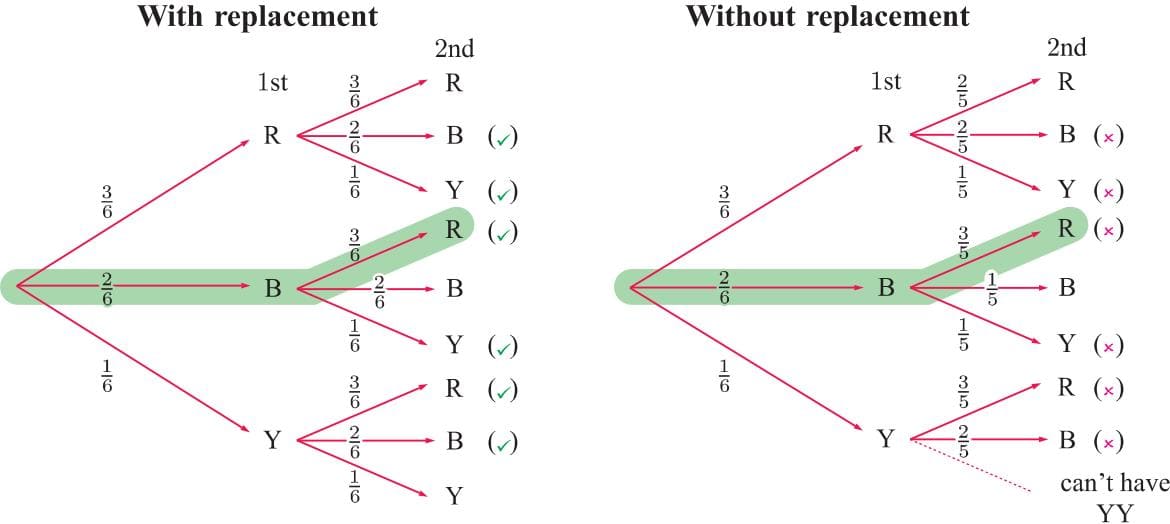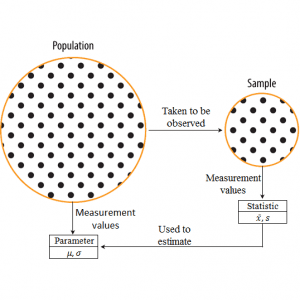Suppose we have a large group of objects. If we select one of the objects at random and inspect it for particular features, then this process is known as sampling.
If the object is put back in the group before an object is chosen again, we call it sampling with replacement.
If the object is put to one side, we call it sampling without replacement.
Sampling is commonly used in the quality control of industrial processes.
Sometimes the inspection process makes it impossible to return the object to the large group. For example:
● To see if a chocolate is hard or soft-centred, we need to bite it or squeeze it.
● To see if an egg contains one or two yolks, we need to break it open.
● To see if an object is correctly made, we may need to pull it apart.
Consider a box containing 3 red, 2 blue, and 1 yellow marble. If we sample two marbles, we can do this either:
● with replacement of the first before the second is drawn, or
● without replacement of the first before the second is drawn.
Examine how the tree diagrams differ:

The highlighted branch represents a blue marble with the first draw and a red marble with the second draw. We write this as BR.
Notice that:
● with replacement (independent events), P(two reds) =3/6×3/6=¼
● without replacement (dependent events), P(two reds) =3/6×⅖=⅕

Let’s assume we have a jar with 10 green and 90 white marbles. If we randomly choose a marble, what is the probability of getting a green marble?
The number of all marbles: N=10+90 =100
The number of green marbles: n=10
Probability of getting a green marble:

There is one important concept in problems with marbles/cards/balls. When the first marble is removed from a jar and not replaced, the probability for the second marble differs (9/99 vs. 10/100). Whereas in case of a coin or dice the probabilities are always the same (⅙ and ½). Usually, a problem explicitly states: it is a problem with replacement or without replacement.
Q1. (i) A lot of 20 bulbs contain 4 defective ones. One bulb is drawn at random from the lot. What is the probability that this bulb is defective?
(ii) Suppose the bulb drawn was not defective and not replaced. Now a bulb is drawn at random from the rest. What is the probability that this bulb is not defective?
solution:
Total number of possible outcomes n(S)=20 (20 bulbs)
(i) E→ be event of getting defective bulb.
Number of favorable outcomes n(E)=4 (4 defective bulbs)
The probability is

(ii) Bulb drawn in is not detective & is not replaced remaining. Bulbs =15 good+4 bad bulbs =19
Total number of possible outcomes n(S)=19
E→ be event of getting a non-defective
Number of favorable outcomes n(E)=15 (15 good bulbs)

Q2. A box contains 3 red, 2 blue and 1 yellow marble. Find the probability of getting two different colours:
a) if replacement occurs
b) if replacement does not occur.
solution:
To answer this question we use the tree diagram above.
a) P(two different colours)
=P(RB or RY or BR or BY or YR or YB)

b) P(two different colours)
=P(RB or RY or BR or BY or YR or YB)

In (b), “2 different colours” and “2 same colours” are complementary events.
∴P(2 different colours) =1-P(2 the same) =1-P(RR or BB)
Q3. A bag contains 5 red and 3 blue marbles. Two marbles are drawn simultaneously from the bag. Determine the probability that at least one is red.
solution:
P(at least one red)=P(RR or RB or BR)

Alternatively, P(at least one red)=1-P(no reds) {complementary events}
=1-P(BB) and so on.
Drawing simultaneously is the same as sampling without replacement
Q4. Two cards are drawn without replacement from a deck of 52 cards. Find theprobability that they are both clubs.
solution:
There are 52 cards and 13 clubs, so the probability that the first card is a club is 13/52.There are 51 cards and 12 clubs left, so the probability that thesecond card is a club given the first card was a club and not replaced is 12/51.
Hence, P(club and club)=P(club)∙P(club|club)=13/52∙12/51=1/17
Using combination formula:

Q5. A football team has 22 players. Eleven play offense and 11 play defense. If threeplayers are selected at random without replacement, find the probability thatall three will be offensive players.
solution:
P(offense and offense and offense)

Q6. I choose 2 balls at random from a bag containing 7 blue and 5 red balls.
Find the probability of getting 2 blue balls if
(a) I replace the first ball before selecting the second
(b) I don’t replace the first ball before selecting the second
solution:
(a) For both selections P(B)=7/12

(b) After I take one blue ball out, there are only II balls left altogether. Only6 of these are blue.

Q7. A packet of sweets has 3 pink, 2 green and 5 blue sweets. Two sweets are removed from the packet. one at a time, without replacement.
a) Draw a tree diagram to determine ALL possible outcomes. Indicate on your diagram the probability associated with each branch of the tree diagram.
Determine the probability that …
c) both sweets are blue.
d) a green and a pink sweet are selected.
solution:
a)

Q8. If 12% of adults are left-handed, find the probability that if two adults are selected at random, both will be left-handed.
solution:
The probability of selecting two people who are left-handed is

It has the same meaning as getting two items one by one without replacement.

Q9. Approximately 9% of men have a type of color blindness that prevents them from distinguishing between red and green. If two men are selected at random from a large group of men, find the probability that both will have this type of color blindness.
solution:
Since the group of men is very large, selecting one man does not radically change the probability that another man will be selected. Let C = red-green
color blindness; then P(C and C)=P(C)∙P(C)=(0.09)(0.09)=0.0081.
Actually:
The probability of selecting two people who have the type of color blindness is

It has the same meaning as getting two items one by one without replacement.







